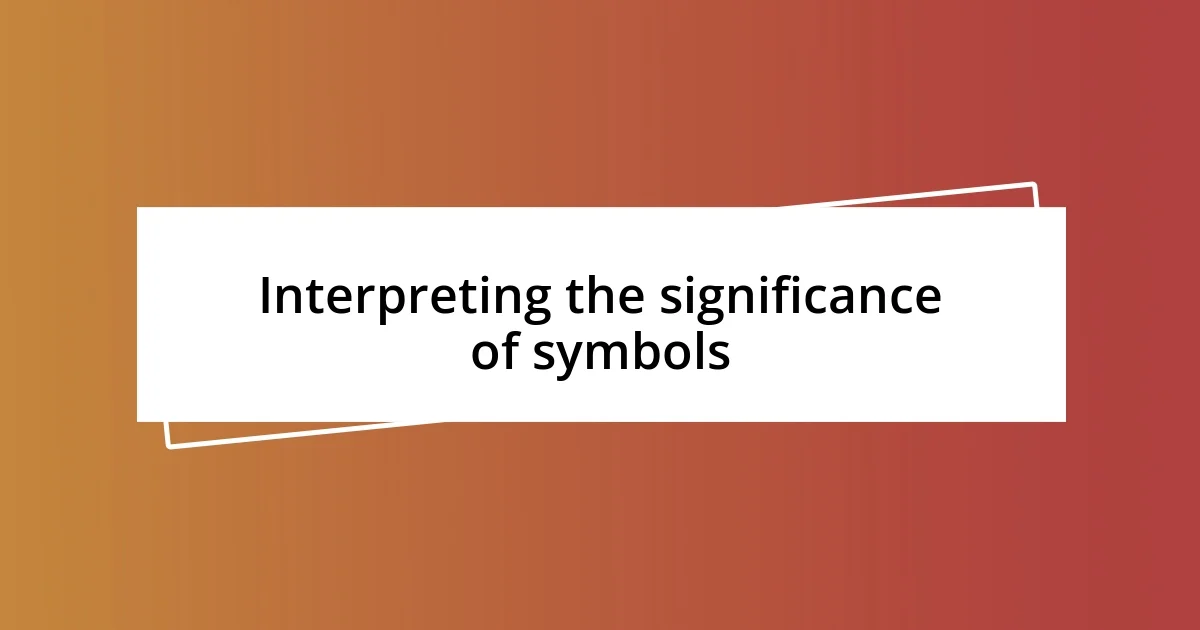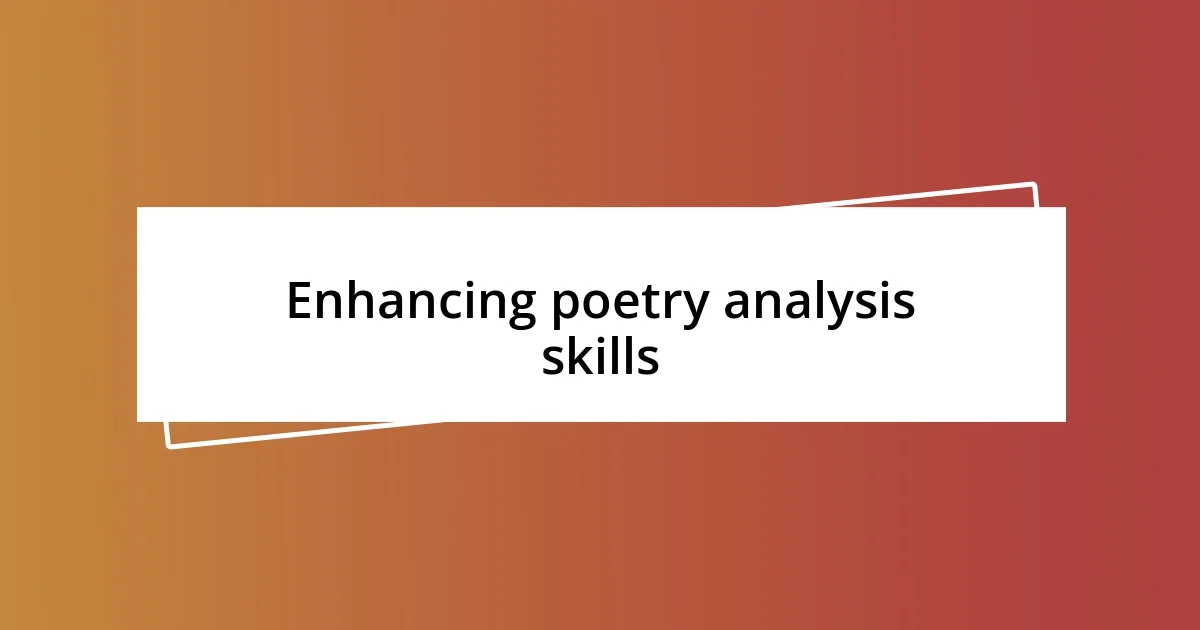Key takeaways:
- Symbolism adds emotional depth and complexity to poetry, allowing readers to connect personal experiences with the themes presented.
- Analyzing symbols through various methods, such as contextual reading and personal reflection, enhances understanding and appreciation of poetic meaning.
- Engaging with poetry through discussion and physical recitation enriches interpretation and reveals the diverse meanings that symbols can evoke.

Understanding symbolism in poetry
Symbolism in poetry serves as a powerful tool that adds layers of meaning beyond the literal words on the page. When I first encountered this concept, I was struck by how a single image could evoke complex emotions and ideas. For instance, consider a rose—on the surface, it represents beauty, but delve deeper, and it can symbolize love, transience, or even pain depending on the context of the poem. Isn’t it fascinating how something so simple can encapsulate such depth?
Reflecting on my experiences with poetry, I remember reading a poem that utilized the changing seasons to depict the speaker’s emotional journey. The imagery of winter’s starkness resonated with me during a time of personal loss. It became clear that the seasons were not just a backdrop; they embodied the essence of grief and healing. This realization made me appreciate how effectively symbolism can mirror our own human experiences.
Have you ever paused to consider why certain symbols resonate with you? I find that personal connections can profoundly influence our interpretation of symbolic elements in poetry. For me, skies often symbolize freedom, shaped by the memories of childhood afternoons spent daydreaming. It’s these emotional insights that transform poetry from mere words into a vivid exploration of our inner lives.

Importance of symbolism analysis
Symbolism analysis plays a crucial role in understanding the deeper layers of poetry. When I dive into a poem, the symbols often leap out at me, adding an entirely new dimension that I might overlook on a surface reading. For instance, I recall reading a poem where the ocean was used to symbolize the vastness of human emotions. The moment I recognized that, it made me reflect on how the tides mirror our own emotional ebbs and flows. Isn’t it intriguing how symbols can articulate feelings that words alone struggle to capture?
As I analyze symbolism, I find it essential for connecting the poet’s intentions with the reader’s experience. One piece that left a lasting impression on me featured the recurring motif of a candle flickering in the dark. It resonated deeply, as it reminded me of resilience during challenging times. This connection highlighted how symbols can serve as bridges, linking us intimately with the themes presented in the poetry. Have you ever experienced a symbol that seemed to speak directly to your heart?
What’s particularly fascinating is how different readers can draw various interpretations from the same symbol. In my experience, a single motif—a broken mirror, for example—can evoke themes of fracture, identity, or even transformation. Each encounter offers a unique lens through which to explore the poem’s message. This variance in interpretation reinforces the importance of analyzing symbolism, as it enriches our understanding and appreciation of the art form.
| Aspect | Symbolism Analysis |
|---|---|
| Emotional Depth | Adds layers of meaning that resonate personally. |
| Reader Connection | Bridges the gap between the poet’s voice and the reader’s experience. |
| Interpretive Variety | Encourages diverse interpretations enriching the artwork. |

Methods to identify symbolism
To effectively identify symbolism in poetry, I often lean on several methods that have proven insightful in my own analysis. One technique I’ve found invaluable is looking for repeated images or motifs throughout the poem. For example, if a tree appears consistently, it might represent growth or stability, which could mirror the speaker’s emotional journey. Context is key; understanding the overall theme helps clarify the symbols’ significance.
Here are some methods I frequently use to peel back the layers of meaning:
- Contextual Reading: Analyze the surrounding text to discern the specific connotations of a symbol.
- Personal Reflection: Consider your emotional responses to the imagery; sometimes, your feelings can reveal deeper meanings.
- Cultural References: Research the symbolic meanings rooted in different cultures, as they can significantly alter interpretation.
- Sound and Rhyme: Listen for phonetic patterns or rhyme schemes that may emphasize certain symbols, giving them more weight.
- Contrast and Juxtaposition: Look for symbols that contrast with one another, as their differences can enhance the overall message.
I remember a poem where the stark contrast between the warmth of a sunbeam and the coldness of shadows played a crucial role. At first, I was drawn to the beauty of the sunbeam, but when I considered the shadows, it evoked feelings of uncertainty and hidden fears. This duality enriched my understanding, revealing that nature’s elements can embody the complexities of our inner landscapes. Such discoveries ignite a sense of wonder within me that makes each poetry reading an adventure of its own.

Analyzing poetic devices and themes
Analyzing poetic devices is like peeling back layers of an onion; each layer reveals something new and intriguing. One of my favorite approaches is examining the use of imagery, which paints vivid pictures that resonate on an emotional level. I remember reading a poem that described a withering flower in detail. Initially, it struck me as a simple image, but upon further reflection, I realized it symbolized lost hope and fading dreams. Have you ever found a single image that changed your entire understanding of a piece?
Themes, too, speak volumes when intertwined with specific devices. For instance, I’ve come across poems that weave together the theme of time with the ticking of a clock in the background. The clock’s relentless movement created an urgent atmosphere, reminiscent of life’s fleeting moments. Isn’t it fascinating how a straightforward device can amplify a theme and elicit deep emotions? This blend of devices and themes in poetry heightens the impact, leaving a lasting imprint on my thoughts long after I’ve finished reading.
As I dive deeper into modern poetry, I’ve noticed how poets often utilize sound devices, like alliteration and assonance, to create a particular mood. I remember a piece that had a soft, whispering quality due to its gentle repetition of ‘s’ sounds. It made me feel as if the words were floating, inviting me to linger on every line. How often do you find yourself captivated by the musicality of a poem? The fusion of sound and meaning brings an additional layer to my analysis, enriching the way I engage with the text.

Interpreting the significance of symbols
When I analyze symbols in poetry, I often find myself reflecting on how they resonate with my own experiences. For instance, I once encountered a poem that featured a storm as a recurring symbol. Initially, I perceived it merely as a weather pattern, yet it gradually dawned on me that it illustrated turmoil within the speaker’s life. This realization struck a chord with me, as there have been moments when I, too, have felt overwhelmed by a figurative tempest. Have you ever recognized a part of yourself in a symbol?
In delving further into symbolism, I appreciate how context can shape meaning. I remember analyzing a poem where rain was depicted as both a cleansing force and a harbinger of sadness. At first glance, I thought it was purely melancholic, but considering the broader narrative unveiled its dual nature. It mirrored my own understanding of how moments of vulnerability can lead to renewal and strength. Symbols often act as mirrors, reflecting our emotions back at us—how do you see them functioning in your interpretation?
As I continue to explore the significance of symbols, I consistently marvel at how varied interpretations can be. I once discussed a poem’s imagery with a friend, focusing on a recurring butterfly. While I viewed it as a symbol of transformation, she perceived it as a fleeting moment—something beautiful yet temporary. Our differing insights led to a rich conversation about how personal backgrounds influence our understanding of symbols. Isn’t it fascinating how a single image can evoke such diverse meanings? Exploring these different perspectives enhances my appreciation for the depth and complexity of modern poetry.

Enhancing poetry analysis skills
It’s amazing how refining your poetry analysis skills can lead to deeper revelations. I remember when I decided to revise my approach to reading poetry. Instead of just skimming through the lines, I took my time to jot down my immediate thoughts and feelings after each stanza. This simple practice transformed my understanding of the entire piece, making me more attuned to nuances I had easily overlooked before. Have you ever tried writing your reactions while reading?
When I dissect a poem, I find that engaging with it aloud opens up new layers. I recall a particular poem where the rhythm danced through my hands as I recited it. Experiencing the sound and flow physically connected me to the text in a way that silent reading never could. It struck me how much a poem’s cadence can mirror its emotional core—how often do you let the music of words carry you away?
Another effective way to enhance poetry analysis is by discussing interpretations with others. I had a memorable evening at a poetry reading group where various perspectives flowed freely. It was eye-opening to hear how different life experiences shaped our understandings of the same poem. One person saw hope in a bleak landscape, while another felt the weight of despair. This dialogue reminded me that poetry is a shared experience, enriching my analysis. How do conversations about poetry influence your perspective?














